p.193
p.197
p.201
p.205
p.211
p.215
p.219
p.223
p.227
Impact of Increased Temperature on Cohesiveness of Textile Glass Reinforcement with UHPC Matrix
Abstract:
The contribution is focused on research results of thin elements with UHPC matrix reinforced by textile glass reinforcement. A set of three test samples with size of 1100 x 120 x 20 mm were produced in laboratories of the Klokner Institute. Using accompanying tests the material characteristics of the concrete matrix and the textile glass reinforcement were determined. This reinforcement is modified by a protective epoxy surface layer, co called coating. The reason of the coating is to prevent a formation and a development of corrosive processes on the reinforcement texture. The samples were tested at four-point bend test in a thermal chamber. The thermal chamber is a space where it is possible to gradually regulate the temperature up to 75 °C under a constant value of a loading. In the course of the temperature increasing is using a measuring unit measured mainly bend in the middle of the span in time and the course of an inner and outer temperature. The impact of the increased temperature on the cohesiveness of the non-conventional reinforcement and the UHPC matrix is evaluated from the monitored data.
Info:
Periodical:
Pages:
211-214
Citation:
Online since:
February 2016
Authors:
Price:
Сopyright:
© 2016 Trans Tech Publications Ltd. All Rights Reserved
Share:
Citation:


